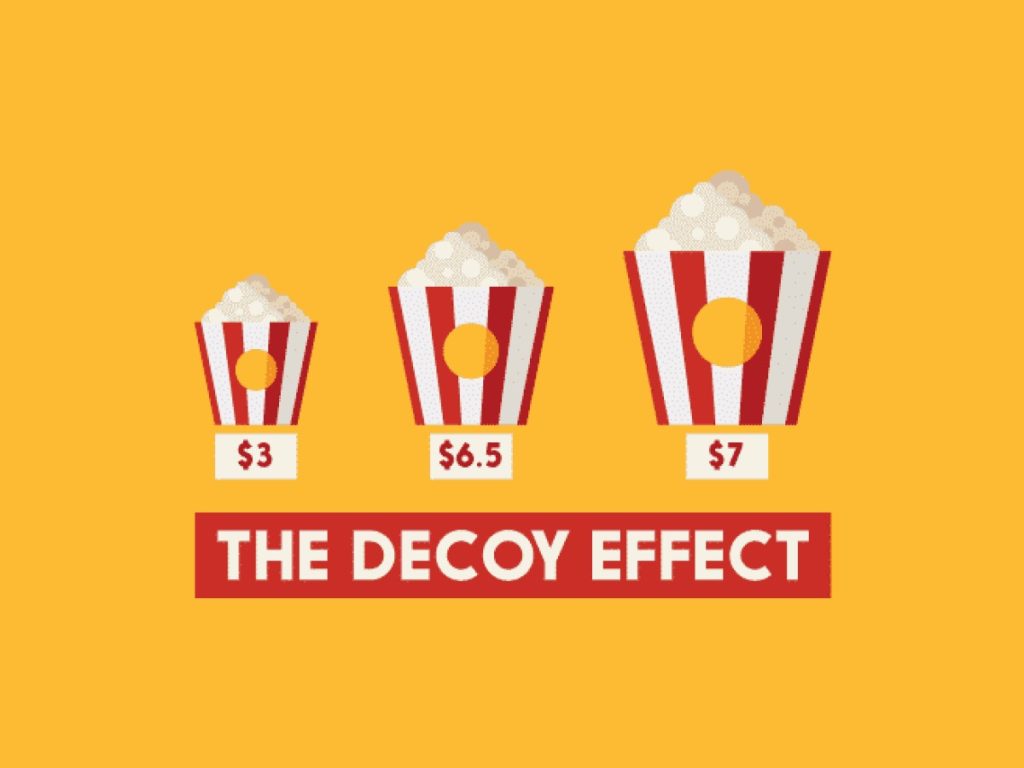In the world of consumer behavior, the Decoy Effect stands out as a powerful psychological phenomenon that influences purchasing decisions. By understanding this concept, businesses can strategically design their product offerings to guide consumers toward a particular choice. This subtle but effective technique can significantly impact sales and customer satisfaction. This makes it an essential tool for marketers and product managers.
What is the Decoy Effect?
The Decoy Effect occurs when a third option—the “decoy”—asymmetrically dominates. This leads consumers to change their preference between two options. Businesses design this decoy to make one of the original choices more attractive, effectively steering consumers toward their preferred option. The introduction of a decoy changes the perceived value of the other options. This leads consumers to make decisions they might not have made otherwise.
To better understand the Decoy Effect, consider a simple example involving product pricing. Imagine a company offers two subscription plans: a basic plan for $10 and a premium plan for $30. These two options might split consumers. However, if the company introduces a third option—a decoy priced at $25 but with fewer features than the premium plan—the $30 premium plan suddenly appears to offer better value. Businesses design the decoy to make the premium plan more appealing, not to encourage selection.
The Psychology Behind the Decoy Effect
The Decoy Effect taps into several psychological principles that influence decision-making. One of the key principles is the concept of “asymmetric dominance,” where the decoy is inferior to one option but not directly comparable to the other. This creates a situation where one option dominates the decoy, making the dominant option appear more attractive in comparison.
Another psychological principle at play is the tendency for consumers to seek value. When presented with multiple options, people often look for the best deal or the most value for their money. The decoy exploits this tendency by making the targeted option seem like the best value, even if it might not have appeared that way without the decoy’s presence.
Additionally, the Decoy Effect leverages the concept of “anchoring.” Anchoring occurs when people rely heavily on the first piece of information they encounter when making decisions. In the context of the Decoy Effect, the decoy serves as an anchor that shifts the consumer’s perception of the other options. By setting a reference point with the decoy, businesses can guide consumers toward a preferred choice.
Practical Applications of the Decoy Effect
Various industries widely use the Decoy Effect to influence consumer behavior. One common application is in pricing strategies. Companies often use decoy pricing to encourage customers to choose a more expensive product or service. For example, in the restaurant industry, menus may include a high-priced dish that few customers will order. However, its presence makes other expensive dishes seem more reasonable, thereby increasing the likelihood of customers choosing those options.
In the technology industry, the Decoy Effect is frequently employed in product bundles. A company might offer three versions of a product: a basic model, a premium model, and a decoy model that is priced close to the premium model but with fewer features. The decoy makes the premium model appear to be the best value, encouraging customers to opt for the higher-priced option.
Subscription services also utilize the Decoy Effect by offering multiple plans with varying features and prices. For instance, a streaming service might offer a basic plan, a standard plan, and a premium plan. By introducing a decoy plan that is close in price to the premium plan but with fewer benefits, the service nudges customers toward the premium plan.
Moreover, the Decoy Effect can be applied in marketing campaigns to increase conversions. Marketers can create promotions where the decoy option is less attractive, making the preferred product or service more appealing. This strategy not only boosts sales but also enhances customer satisfaction by reinforcing the perceived value of the chosen option.
The Ethical Considerations
While the Decoy Effect can be an effective marketing tool, it also raises ethical considerations. Manipulating consumer choices through psychological tactics can be seen as exploitative, especially if consumers are unaware of the influence being exerted on their decisions. Businesses must balance the desire to increase sales with the responsibility to treat customers fairly and transparently.
One way to address ethical concerns is by ensuring that all options, including the decoy, offer genuine value to the consumer. The decoy should not be a completely inferior product that misleads consumers but rather a legitimate option that helps them make an informed choice. Transparency in pricing and product features is also crucial to maintaining trust with customers.
Furthermore, businesses should consider the long-term impact of using the Decoy Effect. While it may boost short-term sales, relying too heavily on this tactic can erode customer trust and damage the brand’s reputation. Companies should use the Decoy Effect judiciously and in conjunction with other value-driven strategies to build lasting relationships with customers.
How to Implement the Decoy Effect in Your Business
For businesses looking to implement the Decoy Effect, it is essential to start with a clear understanding of your target audience and their decision-making processes. Conduct market research to identify the factors that influence your customers’ choices and use this information to design a decoy that effectively shifts their preferences.
When introducing a decoy, ensure that it is positioned close enough in price and features to the targeted option to create a clear contrast. The decoy should be strategically placed to make the desired option stand out as the most logical choice.
Additionally, businesses should test the effectiveness of the Decoy Effect through A/B testing and other analytical methods. By comparing consumer behavior with and without the decoy, you can assess its impact and refine your strategy accordingly. Continuous monitoring and adjustment are key to optimizing the Decoy Effect and ensuring it contributes to your overall business objectives.
The Decoy Effect is a powerful psychological tool that can significantly influence consumer behavior and drive sales. By understanding the Decoy Effect and strategically implementing it in your pricing, product offerings, and marketing campaigns, you can guide customers toward the choices that benefit both them and your business. However, it is important to use this tactic ethically and transparently, ensuring that customers feel satisfied with their decisions. When used effectively, the Decoy Effect can be a valuable component of a comprehensive marketing strategy that enhances customer engagement and boosts profitability.


